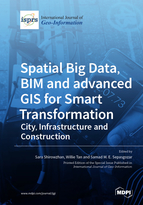Spatial Big Data, BIM and advanced GIS for Smart Transformation: City, Infrastructure and Construction
A special issue of ISPRS International Journal of Geo-Information (ISSN 2220-9964).
Deadline for manuscript submissions: closed (15 January 2020) | Viewed by 43583
Special Issue Editors
Interests: sensing technologies; AI; machine learning; advanced GIS; BIM; digital twins; city analytics methods; digital construction; smart cities; smart construction
Special Issues, Collections and Topics in MDPI journals
Interests: megaprojects; project finance; geomatic engineering; urban management
Special Issues, Collections and Topics in MDPI journals
Interests: sustainability; energy efficiency; artificial intelligence; smart city; digital twin; applications of the internet of things; advanced GIS; LiDAR; BIM; digital technology in infrastructure; mixed reality applications; information and communication technology; spatial analysis and visualization; authentic education
Special Issues, Collections and Topics in MDPI journals
Special Issue Information
Dear Colleague,
The United Nations Economic Commission initiated a program investigating the United Smart Cities (see https://sustainabledevelopment.un.org/partnership/?p=10009 ). There are many other initiatives of smart cities across the world. However, the main requirement of a successful smart city in the implementation phase depends on the availability of the appropriate digital information systems. This special issue invites all researchers to share their scholarly work concerning the development of advanced technologies which may help the implementation of smart cities.
One of the key messages of the Habitat III regional report on housing and urban development is that the digital revolution brings “massive opportunities and challenges to cities.” (see http://radar.gsa.ac.uk/5268/ ) Since the technology is rapidly advancing, the applications are not fully identified, and all challenges are not accurately addressed. The Special Issue welcomes all technical endeavours, technology case studies, and experimentations related to Geospatial Information Systems and other compatible technologies carried out to address one of the many challenges encountered by smart cities, smart construction, infrastructure maintenance, and disaster management.
The International Telecommunication Union (ITU) as the United Nations specialized agency in the field of telecommunications, information, and communication technologies (ICTs) defines a “smart city” as
"A smart sustainable city is an innovative city that uses information and communication technologies (ICTs) and other means to improve quality of life, efficiency of urban operation and services, and competitiveness…".
This Special Issue invites all researchers to share their scholarly work concerning the development of advanced technologies that may facilitate the implementation of smart cities. It will cover topics such as:
- Use of Geo-ICT for planning smart cities
- Geospatial data acquisition for smart cities
- Geospatial database management
- Big data analytics for smart cities
- Real-time location intelligence
- Use of geospatial data for smart urban management, particularly infrastructure planning, construction, and maintenance
- Real-time monitoring of urban environment including air, water, and noise
- Use of geospatial data for planning and building resilient cities, including security and disaster responses.
Dr. Sara Shirowzhan
Prof. Willie Tan
Dr. Samad M. E. Sepasgozar
Guest Editors
Manuscript Submission Information
Manuscripts should be submitted online at www.mdpi.com by registering and logging in to this website. Once you are registered, click here to go to the submission form. Manuscripts can be submitted until the deadline. All submissions that pass pre-check are peer-reviewed. Accepted papers will be published continuously in the journal (as soon as accepted) and will be listed together on the special issue website. Research articles, review articles as well as short communications are invited. For planned papers, a title and short abstract (about 100 words) can be sent to the Editorial Office for announcement on this website.
Submitted manuscripts should not have been published previously, nor be under consideration for publication elsewhere (except conference proceedings papers). All manuscripts are thoroughly refereed through a single-blind peer-review process. A guide for authors and other relevant information for submission of manuscripts is available on the Instructions for Authors page. ISPRS International Journal of Geo-Information is an international peer-reviewed open access monthly journal published by MDPI.
Please visit the Instructions for Authors page before submitting a manuscript. The Article Processing Charge (APC) for publication in this open access journal is 1700 CHF (Swiss Francs). Submitted papers should be well formatted and use good English. Authors may use MDPI's English editing service prior to publication or during author revisions.
Keywords
- Cloud based GIS
- BIM
- big data GIS applications
- Lidar
- geospatial artificial intelligence
- deep and machine learning
- spatiotemporal data analysis
- imaging and scanning data in GIS
- location tracking
- global positioning system
- smart city, infrastructure and construction
- disaster management
- building Information systems
- emergency responses








